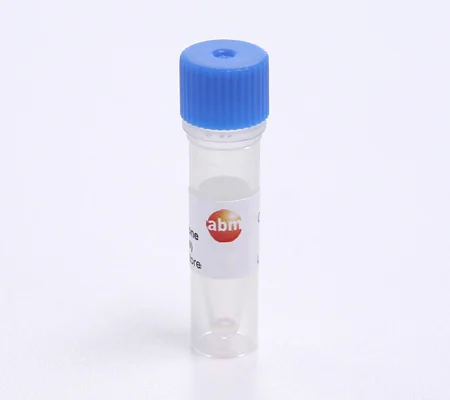
EF1α Polytronic Thomson Factor Lentivirus without GFP

| CAT.NO | UNIT |
|---|---|
| G414 | 200 μl |
| Description | The 3rd generation polycistronic lentivirus expresses all of the four human transcription factors (hOSNL of Thomson set: Oct4, Sox2, Lin28 and Nanog) within a single expression cassette under the control of EF1α promoter. Each of the factor's ORF is separated by a unique 2A peptide (P2A, T2A, and E2A) sequence, which allows for the equivalent expression of all four transcription factors from a single vector. The expression of all factors from a single virus minimizes the number of proviral integrations required for successful reprogramming. This also reduces the risk of insertional mutagenesis effects in the resultant induced pluripotent stem (iPS) cells when compared to those generated using four independent viruses. Also, the virus is provided as concentrated and VSV-G pseudotyped stock capable of transducing both dividing and non-dividing cells. A control GFP lentivirus is included for the easy tracking of gene transduction efficiency in your target cells. |
|---|---|
| SKU | G414 |
| Species | Human (H. sapiens) |
| iPSCS Factor Type | Lentivirus |
| iPSC Factor | Thomson Protocol |
| Gene Name | Oct4, Sox2, Nanog and Lin28 |
| Titer | 1x107 IU/ml |
| Shipping Conditions | On Dry Ice |
| Storage Condition | -70°C |
| Caution | For Research Use Only, not for therapeutic or diagnostic purposes. |
| Function | The recombinant polycistronic lentivirus is provided as a VSV-G pseudotyped and concentrated virus stock capable of infecting both dividing and non-dividing cells. The expression of these transcription factors has been shown to reprogram adult human fibroblasts to an embryonic stem (ES) cell-like state known as the induced pluripotent stem cell (iPSCs). |
| Unit quantity | 200 μl |
| QC | Viral titer (IU/ml) is determined by quantitative RT-PCR of viral stock preparation. Transcription factor protein expression are verified by immunocytochemistry and Western Blot analysis of transduced 293 cells. All of ABM's viral preparations are tested to be free of bacteria and other microbials. |
Supporting Protocol
MSDS
QC
Other
What is the transfection efficiency for the minicircles?
Minicircles have lower transfection efficiency than infection with viral particles. However, minicircles are safer for the cells because they do not have additional non-coding components.
What volume and concentration is the minicircle DNA provided at?
Minicircle DNA products are provided as 100ug DNA at 0.5ug/ul concentration (200 ul total volume).
What is the difference in promoters between LV028873 and LV028874?
LV028873 PL-SIN-EOS-C(3+)-EiP Lentivirus Includes C(3+), trimer of CR4 enhancer LV028874 PL-SIN-EOS-S(4+)-EiP Lentivirus Includes S(4+), tetramer of SRR2 enhancer
Do you offer a protocol for iPSC generation using episomal plasmids?
There are several papers referencing a number of methods of iPSC generation, these have been included below for more information. Further to this, we can offer no standard protocol for using these plasmids, and this will need to be optimized and determined by the end user in all cases. 1. Liao J, Wu Z, Wang Y, et al. Enhanced efficiency of generating induced pluripotent stem (iPS) cells from human somatic cells by a combination of six transcription factors. Cell Res. 2008;18:600-603. 2. Dowey SN, Huang X, Chou BK, et al. Generation of integration-free human induced pluripotent stem cells from postnatal blood mononuclear cells by plasmid vector expression. Nat Protoc. 2012;7:2013-2021. 3. Meng X, Neises A, Su R-J, et al. Efficient Reprogramming of Human Cord Blood CD34+ Cells Into Induced Pluripotent Stem Cells With OCT4 and SOX2 Alone. Mol Ther. 2012;20:408-416. 4. Su R-J, Baylink DJ, Neises A, et al. Efficient Generation of Integration-Free iPS Cells from Human Adult Peripheral Blood Using BCL-XL Together with Yamanaka Factors. PLoS One. 2013;8:e64496. 5. Okita K, Yamakawa T, Matsumura Y, et al. An efficient nonviral method to generate integration-free human-induced pluripotent stem cells from cord blood and peripheral blood cells. Stem Cells. 2013;31:458-466.
Can I amplify these episomal vectors?
All commonly used bacterial strains (such as DH5alpha) can be used to propagate these plasmids, please also review the vector information/map for the corresponding resistance marker.
There are no references for this product yet!


